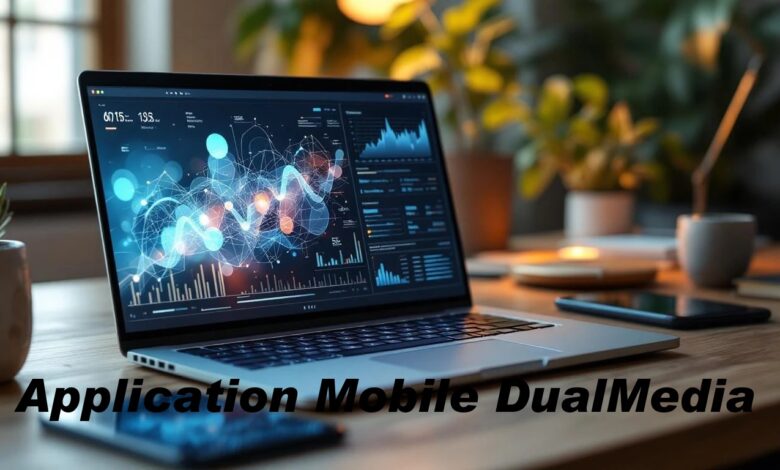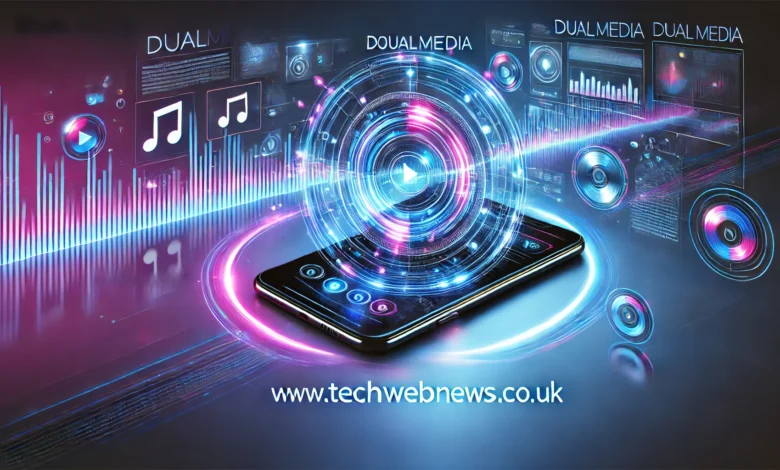Application Mobile DualMedia: A Game-Changer in the Digital Age

Introduction to Application Mobile DualMedia
Application Mobile DualMedia When we talk about mobile applications today, we usually imagine apps that either provide entertainment, productivity, or communication. But the term “Application Mobile DualMedia” introduces something far more dynamic. It suggests a solution that blends two forms of media—whether text with video, images with sound, or any other hybrid form—into a seamless user experience. In an age where attention spans are shrinking and demand for interactivity is growing, such apps are not just a trend; they’re the future.
DualMedia applications stand out because they don’t stick to one channel of engagement. Instead, they focus on giving users a richer, more versatile platform that caters to multiple senses at once. Imagine reading an article with embedded live commentary, or watching a video that automatically links to written summaries and interactive graphics. That’s the promise of an Application Mobile DualMedia.
The rise of this concept is tied closely to the growth of digital literacy and the shift in consumer behavior. People now expect more than static content. They want layers, interactivity, and convenience. This is why businesses, educators, and creators are all looking into how Application Mobile DualMedia can help them connect more effectively with their audiences.
Why DualMedia Matters in Today’s Mobile World

The demand for Application Mobile DualMedia that blend media isn’t just a passing wave—it’s a response to very real user needs. Mobile users spend hours every day engaging with content, and most prefer apps that offer a dynamic experience instead of one-dimensional features. DualMedia fills this gap perfectly.
First, there’s the element of engagement. Single-media apps—whether text-based blogs or video platforms—often limit how deeply users can interact. But when you bring in two Application Mobile DualMedia streams, you make the app inherently more engaging. A learner can read notes while listening to an explanation. A shopper can view a product in 3D while simultaneously reading reviews. This interplay creates stickiness, keeping people hooked longer.
Second, it provides inclusivity. Not everyone learns or consumes content the same way. Some people are visual learners, others prefer reading, and some absorb more through audio. By combining two forms of media, Application Mobile DualMedia applications ensure broader accessibility and appeal. This inclusivity is especially powerful for education, training, and communication apps.
Lastly, Application Mobile DualMedia makes apps future-ready. The mobile world is leaning toward immersive technologies like AR and VR, both of which rely on layered media. A DualMedia app today is like a stepping stone toward that immersive tomorrow. Businesses that adopt it now position themselves ahead of competitors who are still sticking with single-format apps.
Key Features of an Application Mobile DualMedia
To understand the real power of these apps, let’s break down the features that typically define them. A good Application Mobile DualMedia is not just about mixing media randomly—it’s about creating harmony and usability.
One defining feature is synchronized content delivery. This means that text, video, and audio don’t just exist side by side, but actually complement one another. For instance, while watching a tutorial, the app could automatically highlight the written steps being discussed. This coordination helps reduce confusion and keeps the experience smooth.
Another crucial aspect is customization. Users should be able to switch between media types depending on their preference. For example, someone might want to read an article while commuting but watch its video version later at home. A Application Mobile DualMedia app lets them toggle between these without losing progress or context.
Finally, interactivity plays a huge role. Application Mobile DualMedia often include features like clickable captions, audio summaries, or interactive infographics. These not only enhance learning and engagement but also give users control over how they consume content. The more autonomy users have, the more satisfied they tend to be.
Practical Application Mobile DualMedia in Different Industries
The potential of Application Mobile DualMedia extends across multiple industries, and each one can use it differently to achieve better results.
In education, these apps are a blessing. Students no longer need to choose between reading textbooks or watching lectures—they can do both at once. A Application Mobile DualMedia app can allow a student to read notes while simultaneously listening to the professor’s explanation. This not only caters to different learning styles but also reinforces knowledge retention.
In e-commerce, the shopping experience becomes more interactive. Customers can watch a demonstration video of a product while scrolling through written specifications and user reviews. This way, they don’t have to bounce between multiple platforms to get the full picture. The result? Faster decisions and higher satisfaction.
In entertainment, Application Mobile DualMedia offers creativity at its peak. Imagine listening to a podcast that shows synchronized infographics, or playing a mobile game where storyline text appears alongside cinematic visuals. This layered approach gives entertainment apps more depth and keeps users coming back for more.
The Business Advantages of Developing a Application Mobile DualMedia
From a business perspective, investing in a Application Mobile DualMedia mobile application can open doors to long-term growth and customer loyalty.
One of the biggest advantages is higher user engagement. When users can engage with content in multiple ways, they spend more time on the app. This translates to better retention rates, which is vital in a market where app abandonment is common.
Another clear benefit is wider market reach. Since Application Mobile DualMedia apps cater to multiple learning and consumption styles, they naturally attract a more diverse audience. Businesses don’t need to create separate platforms for readers, watchers, or listeners—the app covers all of them in one place.
Lastly, there’s the advantage of brand differentiation. In a crowded app marketplace, standing out is tough. A well-designed Application Mobile DualMedia application instantly communicates innovation and user focus. It shows that the business is forward-thinking and committed to giving users a richer experience. That kind of perception can make all the difference.
Challenges and Considerations in Building a Application Mobile DualMedia
Of course, developing an Application Mobile DualMedia isn’t without its challenges. The concept is powerful, but execution requires careful thought.
The first challenge is technical complexity. Combining two Application Mobile DualMedia streams in a single app requires advanced frameworks, seamless synchronization, and strong backend support. If not implemented correctly, it can lead to glitches, lags, or poor user experience.
Then there’s the issue of cost and resources. Application Mobile DualMedia apps require more investment than standard single-media apps because of the added development, testing, and content creation. Small businesses or startups may find it challenging to allocate the necessary budget.
Another key factor is user overload. While multiple Application Mobile DualMedia streams can be engaging, they can also overwhelm users if not designed intuitively. Striking the right balance is crucial—users should feel empowered, not confused. Good UI/UX design becomes the backbone of a successful DualMedia app.
The Future of Application Mobile DualMedia
Looking ahead, DualMedia is set to play a pivotal role in the evolution of mobile Application Mobile DualMedia. With the increasing adoption of 5G networks and cloud computing, the technical barriers to delivering high-quality media simultaneously are gradually disappearing. This will make DualMedia apps more accessible and mainstream.
We can also expect to see stronger integration with emerging technologies. For example, in augmented reality, text instructions could appear alongside interactive 3D visuals. In virtual classrooms, real-time transcripts might pop up while the teacher speaks. These advancements will only strengthen the appeal of Application Mobile DualMedia.
Another future trend is personalized media experiences. AI and machine learning will likely empower Application Mobile DualMedia apps to adjust automatically based on user preferences. If a user often skips text to watch videos, the app might prioritize video content by default. Such personalization will make the user journey even smoother.
Conclusion: Why Application Mobile DualMedia Deserves Attention
The idea of Application Mobile DualMedia is not just a fancy buzzword—it’s a reflection of where digital interaction is heading. By blending different types of media into a unified experience, these apps offer unmatched engagement, accessibility, and future readiness.
For businesses, educators, and creators, embracing Application Mobile DualMedia isn’t just about keeping up with trends; it’s about building stronger, more meaningful connections with audiences. And for users, it’s about enjoying a richer, more versatile way to learn, shop, work, or play.
In short, DualMedia applications are more than apps—they’re ecosystems. They prove that when technology meets creativity, the result is an experience that feels intuitive, immersive, and impactful. As mobile technology continues to evolve, expect to see the term Application Mobile DualMedia become a standard part of the conversation about innovation.



